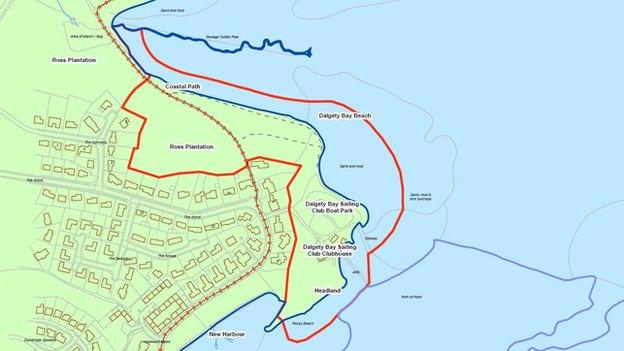Dalgety Bay radiation: MoD's proposals unveiled
- Published

The red line show the site boundary of the affected area at Dalgety bay
A combination of measures may be needed to best deal with radioactive contamination at Dalgety Bay, the Ministry of Defence has said.
The MoD has unveiled four options for the Fife beach, where thousands of radioactive particles have been found.
But it said an "optimised approach" was the likely preferred solution.
This may include removing material from the beach, construction work to contain radioactive material and diverting the public away from it.
It is believed the contamination was caused by WW2 aircraft which were destroyed and dumped in the area.
The MoD was formally named as the polluter by environment agency Sepa last year, and an MoD agency has now drawn up a list of four options.
These are:
Option 1 - Exclude potential users of the beach by erecting a big fence. This has the advantage of being easy to construct and manage.
Option 2 - Coastal defences in key areas would be reconstructed to form a barrier. The aim would be to stop the sea releasing more radioactive materials on the beach. This could also involve a large concrete apron being constructed on the slipway. The radioactive materials would remain in situ.
Option 3 - Excavation of the area to remove the radioactive materials. The report worries that this would take a long time and may not be 100% effective. This option would incur very high costs both for the removal and treatment of the material
Option 4 - Optimised approach - This could be a combination of the above options such as excavating part of the site and covering some of it.
The report said the preferred option would be chosen after further detailed appraisal and consultation.
However, it said a likely preferred solution would be the optimised option involving keeping people out with fences, modifying some of the pathways and excavating the material from some areas.
'Step forward'
Sepa's report into the contamination, which was published last year, said the MoD had routinely incinerated and disposed of aircraft dials in the bay before the town was developed.
The dials had been illuminated by paint containing radium-226.
The aircraft had been stationed at the nearby HMS Merlin airfield, which was commissioned in 1939 as a Royal Naval Aircraft Repair Yard and decommissioned in 1959 before being sold off through the 1960s.
Calum MacDonald, Sepa's executive director, said the MoD's report was a "significant step forward".
He added: "This report outlines the extent of management options which could be adopted at the site, ranging from excluding the public from some areas to encapsulating and/or removing the contamination. We will be working towards a solution which is both effective and durable.
"I believe this is a significant step forward and we are already engaging with local stakeholders regarding the detail of these proposals.
"This is part of the consultative framework intended to get the views of those directly affected by any future works. Sepa is keen to see these works delivered without delay and will work collaboratively with the MoD to ensure momentum continues."
Former Prime Minister Gordon Brown, the MP for the area, said the report was the "first sign of hope for Dalgety Bay after three years of delays and in action".
He called on the MoD to announce at a summit meeting in Dalgety Bay next Monday that they will fund the clean up of the beach area and "end the blight on the town".
The do nothing option is still contained in a new report from the Defence Infrastructure Organisation, entitled the 'Outline Management Options Appraisal', but in words attached to the report the Ministry of Defence back away from doing nothing to the contamination. And in an attached statement they say that "the preferred option is likely to comprise a combination of measures and activities presented."
- Published28 June 2013
- Published6 March 2013
- Published29 October 2012
- Published16 October 2012